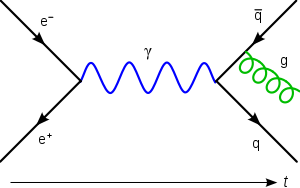Retrocausality
Retrocausality, or backwards causation, is a concept of
Philosophy
Philosophical efforts to understand causality extend back at least to Aristotle's discussions of the four causes. It was long considered that an effect preceding its cause is an inherent self-contradiction because, as 18th century philosopher David Hume discussed, when examining two related events, the cause is by definition the one that precedes the effect.[4][page needed]
In the 1950s,
Physics
Most physical theories are
Macroscopic causality
The imaginary ability to affect the past is sometimes taken to suggest that causes could be negated by their own effects, creating a logical contradiction such as the
Aspects of modern physics, such as the hypothetical tachyon particle and certain time-independent aspects of quantum mechanics, may allow particles or information to travel backward in time. Logical objections to macroscopic time travel may not necessarily prevent retrocausality at other scales of interaction.[13][page needed] Even if such effects are possible, however, they may not be capable of producing effects different from those that would have resulted from normal causal relationships.[14][page needed]
Physicist John G. Cramer has explored various proposed methods for nonlocal or retrocausal quantum communication and found them all flawed and, consistent with the no communication theorem, unable to transmit nonlocal signals.[15]
Relativity
Microscopic causality
Most physical models are time symmetric;[9]: 116 some use retrocausality at the microscopic level.
Electromagnetism
Quantum physics

Retrocausality is associated with the Double Inferential state-Vector Formalism (DIVF), later known as the two-state vector formalism (TSVF) in quantum mechanics, where the present is characterised by quantum states of the past and the future taken in combination.[25][26]
Retrocausality is sometimes associated with the
Tachyons
Hypothetical
Parapsychology
Retrocausality is claimed to occur in some
Efforts to associate retrocausality with prayer healing have been similarly rejected.[39][40]
From 1994, psychologist Daryl J. Bem has argued for precognition. He subsequently showed experimental subjects two sets of curtains and instructed them to guess which one had a picture behind it, but did not display the picture behind the curtain until after the subject made their guess. Some results showed a higher margin of success (p. 17) for a subset of erotic images, with subjects who identified as "stimulus-seeking" in the pre-screening questionnaire scoring even higher. However, like his predecessors, his methodology has been strongly criticised and his results discounted.[41]
See also
- Advanced potential– Type of potential in electrodynamics
- T-symmetry – Time reversal symmetry in physics
- Reversal of temporal order judgment – Perception of events' position in time
- Transactional interpretation – Interpretation of quantum mechanics
- Time's Arrow and Archimedes' Point – Book about retrocausality and philosophical issues in quantum mechanics
- Zeno effect– Quantum measurement phenomenon
References
- ^ a b Faye, Jan (2001-08-27). "Backward Causation". Stanford Encyclopedia of Philosophy. Retrieved 2006-12-24.
- . Retrieved 2006-12-19.
- ISBN 978-0735403611.
- ISBN 9780195202366.
- ^ .
- JSTOR 3326929.
- ISBN 9780773524743.
- ISBN 9780415243391.
- ^ ISBN 978-0195117981.
- ISSN 0556-2821.
- .
- ISSN 0039-7857.
- ISBN 978-3050025995.
- ISBN 978-3540221883.
- ^ J. G. Cramer (April 2014), "Status of Nonlocal Quantum Communication Test" (PDF), UW CENPA Annual Report 2013-14, Article 7.1, retrieved September 21, 2016
- ISBN 978-0393312768.
- ISBN 978-0618257355.
- PMID 10014972.
- ^ .
- S2CID 120117564.
- ISBN 978-3-527-40601-2.
- ^ Feynman, Richard (1965-12-11). The Development of the Space-Time View of Quantum Electrodynamics (Speech). Nobel Lecture. Retrieved 2007-01-02.
- .
- S2CID 118540070.
- S2CID 122168419.
- ^ Aharonov, Yakir & Lev Vaidman. "The Two-State Vector Formalism: An Updated Review" (PDF). Retrieved 2014-07-07.
- S2CID 121964032.
- arXiv:quant-ph/9810060.
- ^ Costa de Beauregard, Olivier (1977). "Time Symmetry and the Einstein Paradox" (PDF). Il Nuovo Cimento (42B).
- ^ David Ellerman (2012-12-11). "A Common Fallacy in Quantum Mechanics: Why Delayed Choice Experiments do NOT imply Retrocausality". Archived from the original on 2013-06-15. Retrieved 2017-05-12.
- S2CID 6916036.
- .
- ^ John Gribbin; Book Review of "An Experiment with Time", New Scientist, 27 Aug 1981, 548.
- S2CID 120918972.
- S2CID 120444688.
- ISBN 9780309037921.
- ISBN 9780879755751.
- ^ Shoup, Richard (2002). "Anomalies and constraints: can clairvoyance, precognition, and psychokinesis be accommodated with known physics?". Journal of Scientific Exploration. 16.
- PMID 11751349.
- PMID 15604179.
- S2CID 51686730. Retrieved 2 November 2017.
